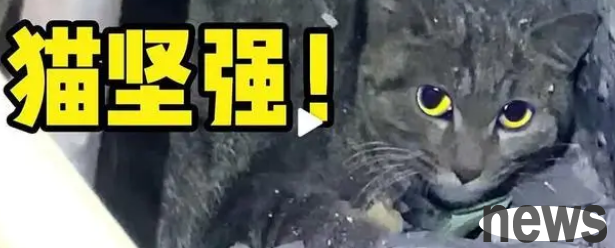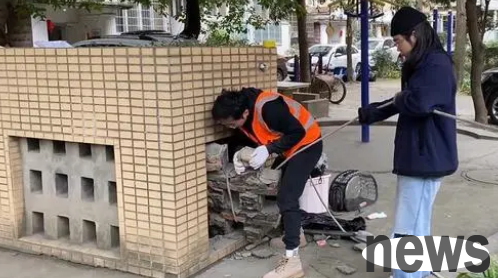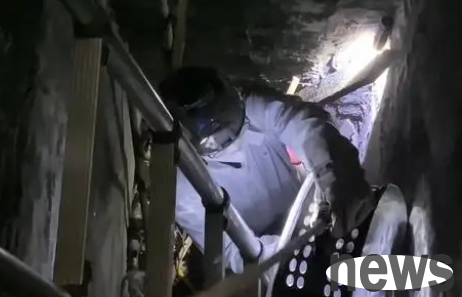A stray cat was driven into a ventilation shaft seven to eight meters deep by an unleashed dog. It stayed trapped for three months. It relied on good Samaritans to feed it until it was successfully rescued.
On March 6, Chengdu’s local cat adoption and rescue platform “Hemaozhu” released a cat rescue video, reviewing the process of rescuing a cat that had been trapped in a ventilation shaft for three months on February 28. This cat can be called "cat strong".

Help: A cat has been trapped in a ventilation shaft for 3 months.
Yuwen (pseudonym), the founder of the "Living with Cats" adoption and rescue platform, told Red Star News reporters that as early as February 23, they received help from the owner of a community in Chengdu, saying that they heard a cat meowing in the ventilation shaft of the community. It had been for a long time and it should not be able to crawl out. "(The owner asking for help) said that he often paid attention to our platform, so he thought of us immediately."
Since the owner needed to be led to enter the community, and after confirming that the cat was not in danger for the time being, Yuwen and his colleagues went to the community for the first time on February 27 to conduct on-site inspections. They found that the ventilation shaft where the cat was trapped was very deep and was surrounded by a brick fence. There was no passage to enter, and rescue was blocked. "We met an elder sister at the scene. She said that the cat had been trapped in the ventilation shaft for at least three months." Yuwen said that the cat was driven in by a dog.
How did the cat survive being trapped for 3 months? The eldest lady said that she fed some food into the ventilation shaft every two or three days and had always wanted to rescue the cat. She spent dozens of yuan to ask the gardening staff in the community to get some branches and put them in, hoping that the cat could climb up on its own, but she had no success.
"The branches are too thin to bear the weight of cats, and cats are timid. Once someone passes by, they will be frightened and dare not climb up." Yuwen said that after they went down the well, they found that the well was seven or eight meters deep, and the height of the branches was not high enough.
The cat was successfully rescued after more than 5 hours.
To rescue the cat, the brick ventilation shaft mesh opening must be removed. After communicating with the property owner, the community owner confirmed that as long as the ventilation shaft can be sealed after the rescue, it can be demolished.
On February 28, after Yuwen and his colleagues prepared the materials to dismantle and restore the mesh opening of the ventilation shaft, the official rescue began.

"If there are no branches in the well and the ground is relatively flat, we can directly use a trap cage to rescue the cat. But there are too many branches and the trap cage cannot fit in, so people have to go in." Yuwen said that after removing the bricks at the mesh entrance, he put on full-body protective equipment and went down the well. In the video released by "Living with Cats", a Red Star News reporter noticed that debris kept falling, and Yuwen also said, "Fortunately, he was wearing a helmet."
Soon, Yuwen entered the ventilation shaft and found the trapped cat in the corner among the branches. In order to alleviate the cat's fear of seeing people, he first threw ham sausage and other food to the cat from a distance. At first, the cat growled in alarm, but as Yuwen slowly approached, he found that the cat did not resist very much. He tentatively touched the cat with gloves on, but the cat didn't put out its paws to resist. So, Yuwen successfully put the cat into the cage, and his colleagues quickly pulled up the cat cage.

After preliminary inspection, Yuwen found that the civet cat had no underlying diseases, but was timid. It was fed by kind-hearted people and had food, so it was not very thin.
Starting at 10:30 a.m. and completing the rescue at around 4 p.m., Yuwen and his colleagues spent more than five hours to successfully rescue the trapped cat. "The eldest sister (who feeds the cats) cooked us a pot of noodles at noon, which was very touching." Yuwen said.
Yuwen told the Red Star News reporter that after the cat was taken back to "live with the cat", it was successfully adopted two or three days later.
Calls himself a "cat firefighter" and hopes more people will adopt instead of buying
"Living with Cats" where Yuwen and his colleagues work is a young cat adoption and rescue platform that was only officially established in 2018. Different from other small animal rescue and protection centers, "Living with Cats" often goes "uphill and down to the sea" to rescue trapped cats, such as those that have climbed to a tree more than 10 meters high and cannot come down, those that have fallen into ventilation shafts and sewers, and those that are trapped in awnings... Yuwen and his colleagues call themselves "Cat Firefighters". To this end, Yuwen also takes the "Special Operations Operation Certificate" exam. In every dangerous rescue, the first thing to do is to ensure safety. "When many people see a trapped cat, they immediately ask for help from firefighters. In fact, firefighters may not know much about the cat's habits, and they don't know what to do after they are rescued. When we rescue trapped cats, we also hope to minimize the work of firefighters and not waste public resources." Yuwen said that this is also "professional people doing professional things."
"Living with Cats" has evolved from simply taking in stray cats, to publishing adoption information, and now to professional rescue. For each rescue, Yuwen and his colleagues will record the process in detail with videos. They hope that through these videos, more people will know about scientific cat raising and promote adoption instead of purchasing.
While preparing to rescue the cat in the ventilation shaft, Yuwen did not forget to educate the onlookers about "developing a good habit of protecting small animals since childhood" and "not bullying stray animals." In the video, a child said, "They (stray animals) also have a difficult life," which was praised by Yuwen and his colleagues.
